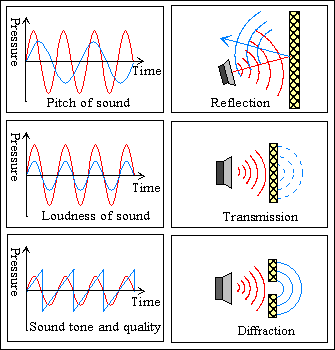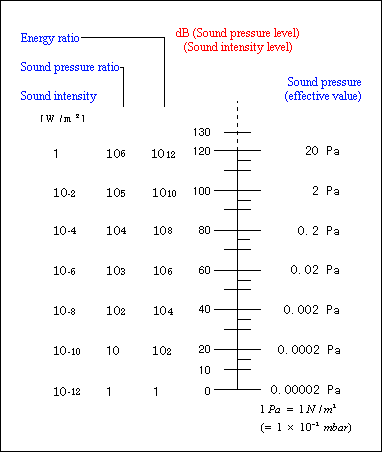Sound (sound waves) is one kind of waves which travel in the medium (air in atmosphere) and is longitudinal waves (compression waves) in which extremely small particles (volumetric particles) composing the medium vibrate in the direction same as the wave travel direction, and at the portion with dense volumetric particles, pressure is higher than the atmospheric pressure and at the disperse portion, it becomes lower. This pressure change from the atmospheric pressure is called "sound pressure" p, and is generally indicated as root of square means of sound pressure (effective value rms). For the unit, Pascal(Pa) or Newton per square meter(N/m2) is used. The frequency range of the sound (audible sound) which humans can feel is around 20Hz to 20kHz, and the range of sound pressure is from 20µPa to 20Pa, and the ratio of the sound pressure of the smallest sound to the largest sound amounts to 106. Noises are a kind of sounds and sounds which are unpleasant to the human ear are specially called noises.
The human is assumed to hear and judge the difference of sounds from the following physical characteristics of sounds.
Pitch of sound
The pitch of a sound is what we call a high sound or low sound, and primarily arises from the difference of sound frequency. There are "A" (pronounced as "aah") in a high voice and "A" in a low voice for the same "A" voice, and this is attributed to the difference in pitch frequency though the shape of the sound wave looks same, and the sound with high pitch frequency is heard high and the sound with low pitch frequency is heard low.
Loudness of sound
There are "A" (pronounced as "aah") in a loud voice and "A" in a small voice for the "A" voice of the same sound pitch, and this is primarily attributed to the fact in that the sound waveform as "A" is similar but the "A" in a loud voice has large amplitudes and the "A" in a small voice has small amplitudes.
Tone and quality
We can hear the difference of the kind of musical instruments which are played in the same loudness and in the same pitch. This is because we hear the difference of sound tone and sound quality delivered from the musical instruments. The sound tone and sound quality have not been thoroughly elucidated even presently but are assumed to be attributed to subtle difference in sound waveform.
Because the sound has the properties as wave, it has properties of "reflection," "transmission," and "diffraction," and attenuates in accordance with the distance. These properties are illustrated below for reference.

When the sound is measured, in general, frequency response and the loudness of the sound are subjected. The frequency uses "Hz" for the measuring unit, as is generally known. The sound loudness uses the logarithmic scale because the range of change is extremely wide. In addition, there is the Weber-Hefner Law in that "the human sensation intensity is proportional to the logarithm of the stimulus quantity," and the logarithmic scale is used because the sense of hearing is one of the sensation intensities. For the unit of logarithmic scale, Bell(B) is used because Alexander Graham Bell of the US first used to express the transmission loss of power in telephone. Since Bell(B) is too large in value, in actuality, decibel(dB) which is one tenth of Bell is used. In addition, in the world handling sound, the "level" is used as a word to express the decibel value. When the "sound loudness" is expressed in decibel, the "level of sound loudness" is expressed to be "a certain dB."
Now, suppose that the effective value of sound pressure of certain sound be p(Pa) and the effective value of reference sound pressure be p0(Pa), the sound pressure level Lp(dB) is given by the following equation.

The reference sound pressure p0 is 20µPa in the case of the sound in air, and is the value close to the minimum audible value for the 1 kHz simple tone of humans with normal hearing sense. The figure below shows the relationship between the sound pressure p(Pa) and sound pressure level Lp(dB), and the sound pressure of 20µPa corresponds to the sound pressure level of 0dB, 1Pa to 94dB, and 20Pa to 120dB. By the way, it is not audible sound but if pressure fluctuation is 0.1 atmospheric pressure (about 10,000Pa), it is 174 dB in the sound pressure level.

A sensor for detecting sound is, in general, called a microphone. The microphone can be classified into dynamic type, electrostatic type, and piezoelectric type in accord with the difference of the conversion system. The dynamic microphone still has big demands primarily in the music world, while the piezoelectric microphone is extensively used primarily for a microphone for low-frequency sound-level meters. For measurement, electrostatic type (condenser) microphones are popularly used because they can be downsized, have flat frequency responses over a wide frequency range, and provide markedly high stability as compared to other types of microphones. The construction of the condenser microphone is shown below.
The condenser microphones are available in two types: bias type and back electret type. The difference is whether the DC voltage is applied from the outside or permanently electrically polarized polymer film is used in place of applying voltage. In general, there is a characteristic in that the bias type provides higher sensitivity and stability.

In selecting microphones, consideration shall be given to the following points.
The size designates a nominal diameter of the microphone. A wide variety of sizes such as 1 inch, 1/2 inches, 1/4 inches, and 1/8 inches are available, but presently, the 1/2-inch type is a mainstream for measurement applications. As the size decreases, the sound field is not disturbed up to high frequencies, which is preferable, but as the size decreases, the sensitivity also decreases, and it becomes difficult to use. In the experiment which avoids the disturbance of the sound field as much as possible, the type with still smaller diameter must be chosen.
There are two types: pressure field type and free field type. In general, the free field type is used, but in a special case where sound inside the duct is measured, the pressure field type is used.
When the microphone is placed in the sound field, the sound pressure P applied to the diaphragm of the microphone becomes a sum (P=P0+?P0) of the sound pressure P0 (field sound pressure) when the microphone is not present and an increment ?P0 generated from placing the microphone. ?P0 differs in accord with the frequency and incidence angle.

The sound pressure type microphone is a type whose frequency response of the output becomes flat against P0+?P0

The free field type microphone is the type whose output frequency becomes flat against P0 of the incidence angle 0 (front incidence).
Even for the free field type microphone, the characteristics at the high-frequency range degrade when the incidence angle is other than 0º, as clear from the figure below, to which care must be taken.

The suitable microphone shall be selected from those with the frequency response which sufficiently covers the band range required for measurement and is flat as possible. When the response to high frequencies is also required, since there is a fear of disturbing the sound field, consideration must be given to the size discussed in Section 4.1. As clear from the figure in Section 4.2, because the band range is limited in which the frequency response is flat in the area other than that in which the response is flat to the incidence sound, care must also be taken to the positional relationship between the sound source and the microphone.
4.4 Temperature Characteristics
The temperature characteristics are important factors which affect the microphone stability. It must be avoided to collect data again because the data collected after having hard time to collect them has no reproducibility. In this sense, it is safer to select the microphone with as small the temperature coefficient as possible. By the way, the measurement microphone MI-1211 of Ono Sokki.Co.Ltd, provides -0.007dB/K, and the MI-1232 provides 0.005dB/K, which are extremely small values.
Intrinsic noise is the size of signal outputted from the microphone whether any sound is inputted into the microphone or not, and when this value is smaller, even a small sound is able to be separated from noise and detected. The MI-1211 has the intrinsic noise of 11dBA, which is the world's smallest level for the 1/2-inch type.
After checking all these factors, the sensor best suited for the measurement objects must be selected.
The specifications and information by applications of measurement microphones of Ono Sokki. Co. Ltd. are summarized in the table below for reference.
| Model | MI-1211 |
MI-1235 |
MI-1433 |
|---|---|---|---|
| Nominal diameter | 1/2 inch |
||
| Response type | Free field type |
||
| Bias voltage | 200 V |
0 V |
|
| Frequency range | 20 to 14 kHz | 20 to 20 kHz | 20 to 8 kHz |
| Sensitivity(re.1V/Pa) | -20 dB ± 1.5 dB re. 1V/Pa | -29 dB ± 3 dB re. 1V/P | |
| Maximum sound pressure level (SPL) | 132 dB (with MI-3310) | 143 dB (with MI-3310) | |
| Intrinsic noise level | 12 dBA or less (A) | 19 dBAor less (A) | |
| Temperature characteristics at 1 kHz | 0.007 dB/K or less | 0.009 dB/K or less | |
| Operating temperature range | -10 to +50 °C | ||
| Operating humidity range | 0 to 90 % RH( with no condensation) | ||
| Applicable products | Designation | Measurement microphone | Sound intensity microphone | IEC type II sound level meter | IEC type I sound level meter | |||
|---|---|---|---|---|---|---|---|---|
| Model | MI-1211 |
MI-1235 | MI-1433 |
MI-6410 |
MI-6420 |
LA-1410 LA-1440 series |
LA-4440 LA-3560 LA3570 series |
|
| Detection method | Bias type condenser type | Back electret type condenser type |
Bias type condenser type | |||||
| Measurement items | Environmental noise measurement | possible | possible | possible | possible | possible | ||
| Mechanical noise measurement | possible | good | possible | possible | possible | |||
| Quality control by sound | good | possible | possible | possible | possible | |||
| Architectural acoustics measurement | possible | possible | good | possible | possible | possible | possible | |
| Sound power level measurement | possible | possible | possible | possible | ||||
| Sound source location | good | possible | ||||||
| Sound field analysis | possible | good | ||||||
The sound level meters are introduced on the information table by applications. This is because the sound level meters are measuring instruments with the microphone integrated with the processor and display unit, and at the same time they are regarded as one of the sound sensors and can be used for analyzing and assaying the output.
For the next time, the "sound level meter" will be discussed as the continuation of the sound sensor.